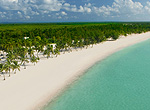Weak dollar opens new property destinations
Destinations where the local currency is pegged to the falling dollar are attracting increasing interest from overseas property investors


The future of international property is green - the exact shade of the dollar. With the American currency trading at nearly $2 for a pound (at current exchange rates) - a level unseen since the early 1980s, according to foreign exchange company Caxton FX British and European investors are waving their wallets at up and coming destinations where the local currency is pegged to the falling dollar. Winkworth International Developments, for example, reports strong interest in the Caribbean and Latin America. Among the next great destinations for 2008, they include the impossibly turquoise waters and palm-fringed coastline of St Vincent and the Dominican Republic, where developers are presently offering up to 10% yields for two years and 100% finance on key-buy new developments ; fiery, sun-drenched Mexico, where high-net American buyers are investing in landmark developments such as Mexico City s Reforma 90; and the lush greenery of Brazil, Argentina and Costa Rica. 'Products where buyers can purchase off plan, with long-term build programmes backed up by a good guaranteed rental offer, are always attractive, but with the dollar rate being so favourable to British and European buyers, we are unsurprised that they are particularly keen on investing in the Caribbean and Americas,' says Charles Peerless, Director of Winkworth International Developments. 'We are seeing interest in a number of islands in the Caribbean, such as Nevis or St Lucia, which have quite a good infrastructure, low crime, but not the same level of development as, say Barbados, agrees James Price of Knight Frank. We are also aware that there us quite a lot of interest in Brazil, although we are still studying how long term that is, as a lot has been on a speculative basis, and quite a few people are looking at Buenos Aires, in Argentina, which is an exciting place, and very European. Certainly a lot of people are looking at dollar products not only because these can grow in value thanks to capital appreciation, but also because they expect the dollar to recover at some stage.' If it makes sense to follow the dollar, it makes even more sense to follow the oil trail after barrel prices hit the $100 mark in January (although they have gone down a little since then). 'The credit crunch [affecting today s economy] is a North American and European affair it certainly does not concern the rich oil nations, says Jonty Crossick of overseas off plan investment specialists Ready2Invest. 'There are countries which export a large amount of oil and there are countries who receive large amounts of cash from the countries that export the large amount of oil. Investors should closely follow both. 'For example, the Gulf Co-operative Countries have just formed an EU type body and you will see ever larger flows of investments across the borders of the members of the GCC, namely Saudi Arabia, the UAE, Qatar, Bahrain, Oman and Kuwait, he adds. Furthermore, these mightily rich nations are pouring their surplus cash into friendly, stable Muslim countries outside the GCC such as Kazakhstan, Turkey and Morocco. The peaceful, rose-scented homes of Morocco in particular are attracting GCC cash in bucket loads , according to Crossick, thanks to the country s political stability and the government s effort to attract 10 million tourists by 2010. This is backed by demand from British and European buyers who are expressing strong interest in luxury developments in Marrakech and some of the country s established seaside resorts. In Morocco, it is also worth looking at Agadir and Tangiers, says Harry Lewis from Savills International, which offer beach, golf and culture with year-round good weather and cheap flights.' Another oil superpower, Russia, is experiencing a property boom at home and fuelling one abroad. One new destination where the Russians are investing heavily is Montenegro: 'it s not only Europe's newest nation, but probably its most beautiful,' says Crossick. A rugged coastline of limestone peaks sloping steeply to the Adriatic Sea and a tortured inland of river-eroded canyons and glacier lakes make the country as appealing as its extremely affordable property prices. [Montenegro is] one of the best emerging markets for value for money, says Savills Lewis. If buyers do their homework and buy through reputable agents, land ownership is not an issue. Knight Frank s Price agrees but warns that, when looking at emerging locations, it is crucial to sift carefully the wheat from the chaff. You need to look at the site, how accessible it is, but also the people behind a development: are they credible, do they have all the planning and titles, are they associated with a blue chip company such as a big hotel group, he says. The degree of uncertainty inherent in investing in emerging markets is driving some of the most cautious buyers towards up and coming locations within more mature destinations such as France, Italy or Portugal, which are perceived as safer and, being closer to home, more eco-friendly choices than a long haul home. For example, the stretch of France between Trouville and Deauville is not an established international market, but we expect quite a bit of demand to spring up there because it is very accessible, and has a good, established interest from the Parisian market, says Knight Frank s Mark Hardy. Madeira is another one. It always had a wrong granny image, but there is a bit of a buzz surrounding it now. And in the Alps, Austria is the place to buy. It offers exceptional value for money and many of the best resorts are within 1 1/2 hours of Salzburg with direct flights from all major UK and Irish airports, says Savills Lewis. Among established destinations, the dollar effect is also boosting demand in places like Barbados, where the favourable exchange rates offsets traditionally strong property prices. As for the US, Crossick recommends looking as far afield as Big island, in Hawaii, which has a lush tropical landscape of papaya trees and orchids, a rich native culture it was the core of the 19th-century Hawaiian kingdom and better property prices than the rest of the archipelago. However, warn the experts at Caxton FX, 'The UK has also had its difficulties, with Alistair Darling recently revising his growth forecast for 2008 at the last budget. With the Bank of England also signalling lower interest rates in the coming months, how long the pound will stay at its current level against the dollar is hard to say. When you consider that the US is currently experiencing a housing market correction, now is certainly a great time to be taking advantage of the exchange rate. * Look out for Country Life International, our magazine dedicated to the overseas property market, published with Country Life on March 6, 2008 * Search through the finest overseas properties
Sign up for the Country Life Newsletter
Exquisite houses, the beauty of Nature, and how to get the most from your life, straight to your inbox.
Country Life is unlike any other magazine: the only glossy weekly on the newsstand and the only magazine that has been guest-edited by HRH The King not once, but twice. It is a celebration of modern rural life and all its diverse joys and pleasures — that was first published in Queen Victoria's Diamond Jubilee year. Our eclectic mixture of witty and informative content — from the most up-to-date property news and commentary and a coveted glimpse inside some of the UK's best houses and gardens, to gardening, the arts and interior design, written by experts in their field — still cannot be found in print or online, anywhere else.
-
 ‘It had the air of an ex-rental, and that’s putting it politely’: How an antique dealer transformed a run-down Georgian house in Chatham Dockyards
‘It had the air of an ex-rental, and that’s putting it politely’: How an antique dealer transformed a run-down Georgian house in Chatham DockyardsAn antique dealer with an eye for colour has rescued an 18th-century house from years of neglect with the help of the team at Mylands.
By Arabella Youens
-
 You're having a giraffe: Country Life Quiz of the Day, April 25, 2025
You're having a giraffe: Country Life Quiz of the Day, April 25, 2025Friday's Quiz of the Day brings your opera, marathons and a Spanish landmark.
By Toby Keel